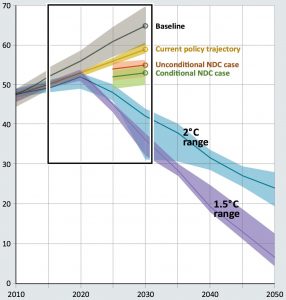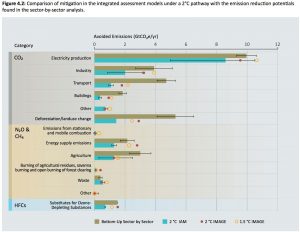My takeaways from the Bonn Climate Summit. Anji Seth
1. COP23 in Bonn was all about “ambition”. In the 2015 Paris Agreement the countries of the world committed to limiting global temperature increase to “well below 2°C above pre-industrial levels and pursue efforts to limit the temperature increase to 1.5°C above pre-industrial levels”.
We knew back then that national pledges made in advance of Paris accounted for only ~1/3 of the emissions reductions required. The Agreement was written with a 5-year review mechanism and transparency that was designed to incentivize increasing national ambition over time.

Meanwhile an Emissions Gap Report is published annually as a check up on how we are doing. The 2017 report (see vox article for excellent summary) came out just before the November Bonn UN climate summit. The good news is that greenhouse gas emissions are coming down in Europe and the US. And that China is on board to begin reductions soon. The bad news is that even if we were all wildly successful at meeting the pledges made for Paris, we’d be only 1/3 of the way to the goal for 2030, and worse, emissions are not ramping down as fast as were planned. More Ambition is needed.
2. Carbon pricing is the key to success – and it appears that method matters. Europe, parts of the US and other regions have set up Emissions Trading Schemes (ETS). An ETS places a cap on emissions and allows for trading of emission permits under the cap. In this method the price is determined by the market with the emissions cap specified and reduced over time. This should lead to increasing price of carbon. Contrary to this expectation, the experience in Europe (and also in the Northeast RGGI emissions market) has been that the cap can reduce emissions in the sectors to which it is applied, however, the price determined by the market has not increased as required. An economist at the German Pavilion at COP23 explained that traders can benefit more overall if the price of emissions is held low. Whereas the ETS carbon price was expected to be equivalent to that from a rising Carbon Fee, experience in the past decade has shown that trading schemes do not achieve an increasing price on carbon that is needed to transform the economy away from fossil fuel. At the time of this writing the price/ton of Carbon in RGGI is ~$5. The Gap Report estimates a price less than $100 would be sufficient to create an economy wide transition. Still many of the new pricing schemes planned around the world are continuing to use ETS. More ambition is needed. And more courage.

3. In the WASI pavilion we learned that the most progressive US states are finding it most difficult to reduce emissions from transportation. The more fuel efficient we make vehicles, the more we drive them! There is lots of discussion about the future of transportation being electrified and autonomous with shared vehicles. The effect of such a transition on emissions remains unclear, and will depend on the fuel source for electricity as well as VMT. If we need to close the emissions gap by 2030 then we have to find a way to reduce emissions from transport.
More ambition is needed. And more courage. And more realism. With no time to waste.